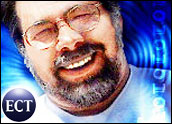
I met Steve Wozniak after he spoke at last month’s MIT Emerging Technologies conference. Standing on the stage, trying to jockey my way among the pack wanting to greet “Woz,” I was torn between wanting to talk to this luminary of Electronic Design’s Hall of Fame and feeling I was adding to his hounding.
When it comes to EEs as celebrities, Wozniak is one of the giants, founding Apple and building the first personal computer. How much more impact could an engineer have on our life and times?
Woz loves the hands-on challenges of engineering. His joy in problem solving is coupled with an inspiration to “provide something that the masses can use” without having to “mold themselves to the technology.” The challenge in creating the Apple I, he said, was to take the technology that existed at the time and use a subset of that technology to create a useful computer that would be affordable for the everyday buyer.
“Price was the number-one key,” he said. “I could afford no output device in 1974, so I designed this terminal to display characters on my Sears TV. The catch was, in 1974, no TVs had video-input connections. I had to take my TV apart to find the proper point to substitute my own TV signal.”
Wheels of Zeus
Wozniak still loves engineering challenges. His startup Wheels of Zeus (wOz) is focused on developing a wireless platform for “location-aware” computing. He’s marrying GPS and wireless technologies to create wOzNet, a wireless network that will serve as a backbone for location, status, control and communications solutions. This could fill the gap between low-range RFID solutions and expensive long-range cellular and paging networks.
Woz’s freespirited dogs inspired wOzNet, as he considered tagging them so he could track them should they go AWOL. From there, tracking possibilities blossomed — cats, kids and personal property all could be tagged. The wOz platform provides the tracking infrastructure: a reference design, wireless network and online service to create a “tracking window” for tagged items.
While GPS tracking has been around for years, the promise of small, low-cost, high-range tracking devices opens many mass applications. The proliferation of the cell phone also creates a whole new universe of tracking applications, as the phone can serve both as a GPS tag and, when equipped with a Web browser, as a tracking window. The ability to marry GPS with portable data services creates a huge “emerging technology” market.
In fact, following Wozniak’s Keynote Panel, the MIT Emerging Technologies’ program offered a session called “WhereWare — The Revolution in Location Aware Computing.” This panel included technologists working on tracking systems for high-density urban areas and indoor settings, which limit GPS.
Indoor Tracking
Hari Balakrishnan of MIT’s Computer Science and Artificial Intelligence Lab described the Cricket indoor tracking system. Beacons placed throughout a building send out both ultrasound and RF signals. “Listeners” pick up the signals, and by running algorithms based on the difference in propagation speeds of RF (speed of light) and ultrasound (speed of sound), the system correlates a location.
Cricket is accurate to within 1 to 3 cm, said BaIakrishnan, adding that applications include tracking patients and equipment, creating games that marry the virtual and physical worlds, and navigation for robotics.
Matthew Rabinowitz, founder of Rosum Corp., presented an ingenious tracking solution using the synchronization signals within digital television standards. Rosum TV-GPS integrates signals from existing commercial TV towers with signals for GPS satellites to support positioning in all environments. The TV positioning technology offers advantages over GPS due to the higher power levels, wider bandwidths, lower frequencies, and “superior geometries” of the TV positioning system.
One possible application for precise indoor positioning, said Rabinowitz, is security for 802.11 wireless networks. “People don’t want others outside of a facility having the ability to access their wireless network. Short of putting up copper wallpaper, knowing where users are is a great way to grant or deny access to a secure network,” he said. Inside a facility, positioning information adds value to the network infrastructure. Users can print to the nearest printer or bring up the data relevant to a certain room in a hospital.
Representing the software side of the location-aware equation was Mark Jacobstein of Digital Chocolate. His company is building a host of location-aware mobile apps: child-finders for kids lost at the mall; “friend-finder” programs for forming casual social groups; commerce applications allowing merchants to broadcast offers to shoppers in a given vicinity; and of course, gaming.
And, Digital Chocolate got quite a lot of press recently with PacManhattan. In this live variation of PacMan in the streets of New York, players used their GPS enabled phones to maneuver around the city to eat or be eaten! So, location-aware computing’s possibilities are fun as well as endless.


































Social Media
See all Social Media